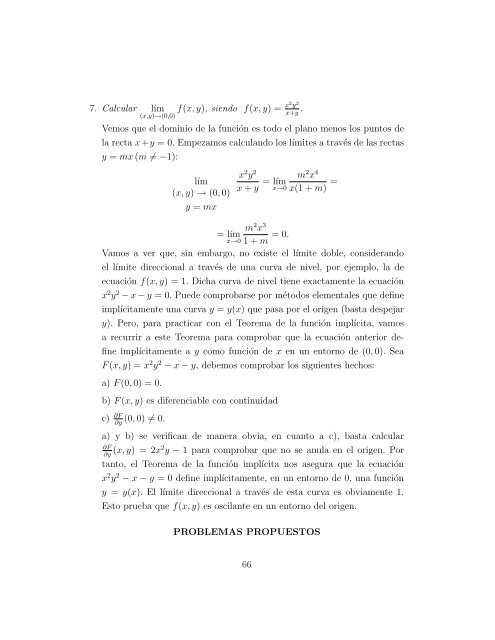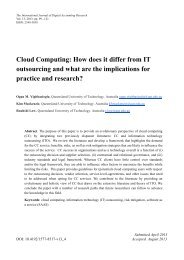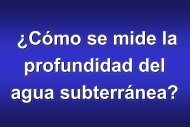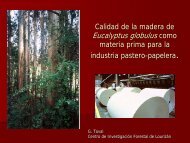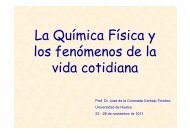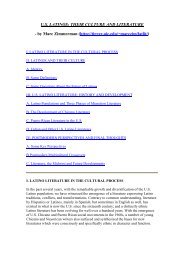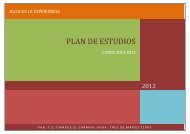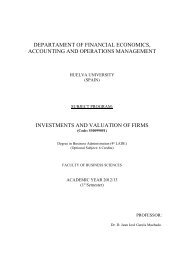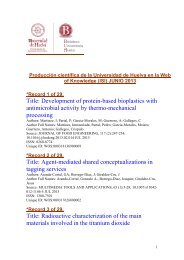2º Regla de la cadena y derivación implícita
2º Regla de la cadena y derivación implícita
2º Regla de la cadena y derivación implícita
You also want an ePaper? Increase the reach of your titles
YUMPU automatically turns print PDFs into web optimized ePapers that Google loves.
7. Calcu<strong>la</strong>r lím<br />
(x,y)→(0,0) f(x, y), siendo f(x, y) = x2 y 2<br />
x+y .<br />
Vemos que el dominio <strong>de</strong> <strong>la</strong> función es todo el p<strong>la</strong>no menos los puntos <strong>de</strong><br />
<strong>la</strong> recta x+y = 0. Empezamos calcu<strong>la</strong>ndo los límites a través <strong>de</strong> <strong>la</strong>s rectas<br />
y = mx (m = −1):<br />
lím<br />
(x, y) → (0, 0)<br />
y = mx<br />
x 2 y 2<br />
x + y<br />
m 2 x 3<br />
= lím<br />
x→0<br />
m 2 x 4<br />
x(1 + m) =<br />
= lím = 0.<br />
x→0 1 + m<br />
Vamos a ver que, sin embargo, no existe el límite doble, consi<strong>de</strong>rando<br />
el límite direccional a través <strong>de</strong> una curva <strong>de</strong> nivel, por ejemplo, <strong>la</strong> <strong>de</strong><br />
ecuación f(x, y) = 1. Dicha curva <strong>de</strong> nivel tiene exactamente <strong>la</strong> ecuación<br />
x 2 y 2 − x − y = 0. Pue<strong>de</strong> comprobarse por métodos elementales que <strong>de</strong>fine<br />
<strong>implícita</strong>mente una curva y = y(x) que pasa por el origen (basta <strong>de</strong>spejar<br />
y). Pero, para practicar con el Teorema <strong>de</strong> <strong>la</strong> función <strong>implícita</strong>, vamos<br />
a recurrir a este Teorema para comprobar que <strong>la</strong> ecuación anterior <strong>de</strong>-<br />
fine <strong>implícita</strong>mente a y como función <strong>de</strong> x en un entorno <strong>de</strong> (0, 0). Sea<br />
F (x, y) = x 2 y 2 − x − y, <strong>de</strong>bemos comprobar los siguientes hechos:<br />
a) F (0, 0) = 0.<br />
b) F (x, y) es diferenciable con continuidad<br />
c) ∂F (0, 0) = 0.<br />
∂y<br />
a) y b) se verifican <strong>de</strong> manera obvia, en cuanto a c), basta calcu<strong>la</strong>r<br />
∂F<br />
∂y (x, y) = 2x2y − 1 para comprobar que no se anu<strong>la</strong> en el origen. Por<br />
tanto, el Teorema <strong>de</strong> <strong>la</strong> función <strong>implícita</strong> nos asegura que <strong>la</strong> ecuación<br />
x 2 y 2 − x − y = 0 <strong>de</strong>fine <strong>implícita</strong>mente, en un entorno <strong>de</strong> 0, una función<br />
y = y(x). El límite direccional a través <strong>de</strong> esta curva es obviamente 1.<br />
Esto prueba que f(x, y) es osci<strong>la</strong>nte en un entorno <strong>de</strong>l origen.<br />
PROBLEMAS PROPUESTOS<br />
66


